Analysis of Sustainable Tourism in Egypt's Development
VerifiedAdded on 2020/10/05
|11
|3461
|352
Report
AI Summary
This report provides a comprehensive analysis of sustainable tourism development, focusing on the context of Egypt. It begins by examining the rationale for planning in the tourism industry and explores how stakeholders, including workers, customers, and local communities, can benefit from tourism development. The report then delves into the advantages and disadvantages of public/private sector tourism planning partnerships. It introduces the concept of sustainability in tourism, analyzes factors that may hinder sustainable development, and outlines different stages in planning for sustainability. Furthermore, the report evaluates methods for resolving conflicts of interest, analyzes the implications of balancing supply and demand, and assesses the moral and ethical issues of enclave tourism. The analysis covers economic, socio-cultural, and environmental impacts, offering a holistic view of sustainable tourism practices and challenges in Egypt. The report utilizes various references to support the findings.
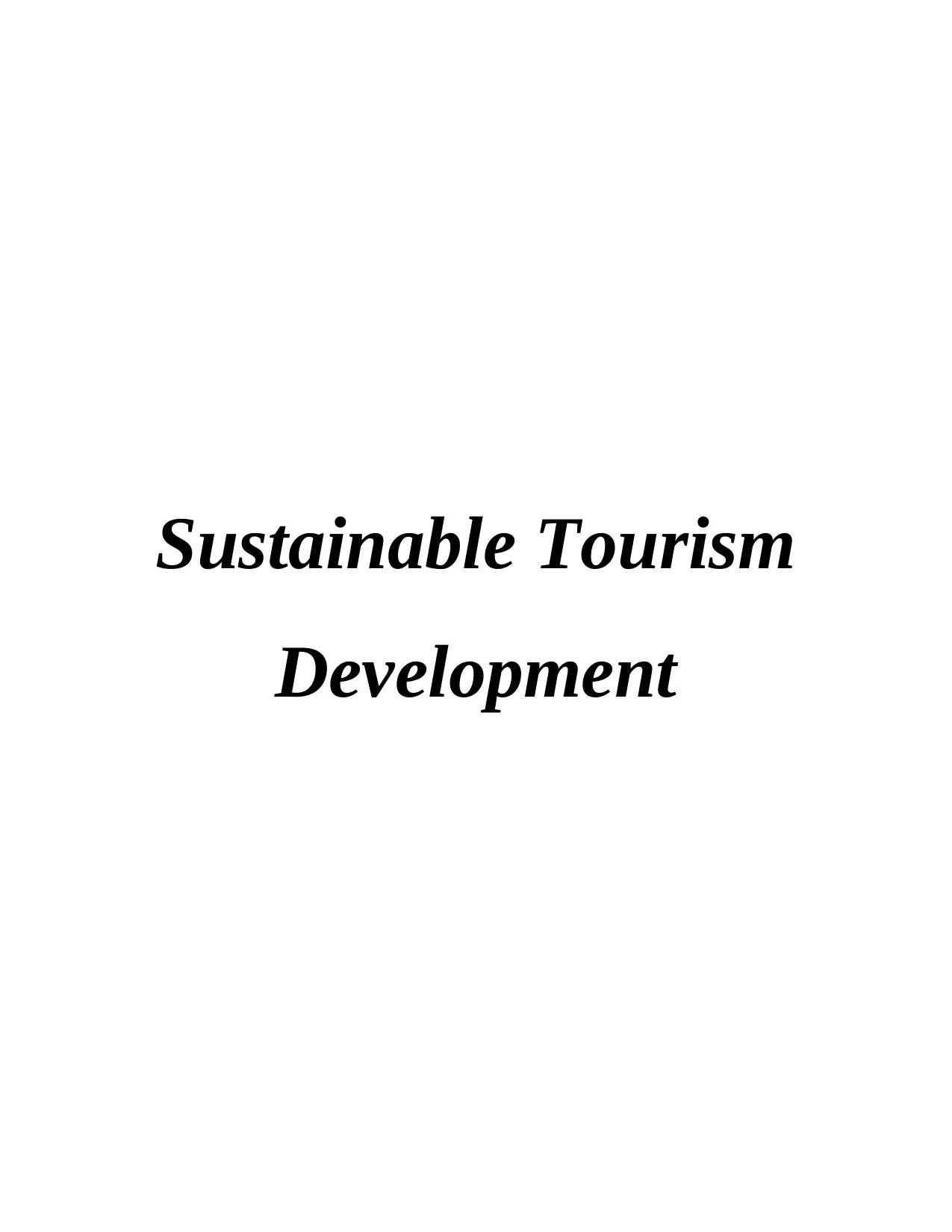
Sustainable Tourism
Development
Development
Paraphrase This Document
Need a fresh take? Get an instant paraphrase of this document with our AI Paraphraser
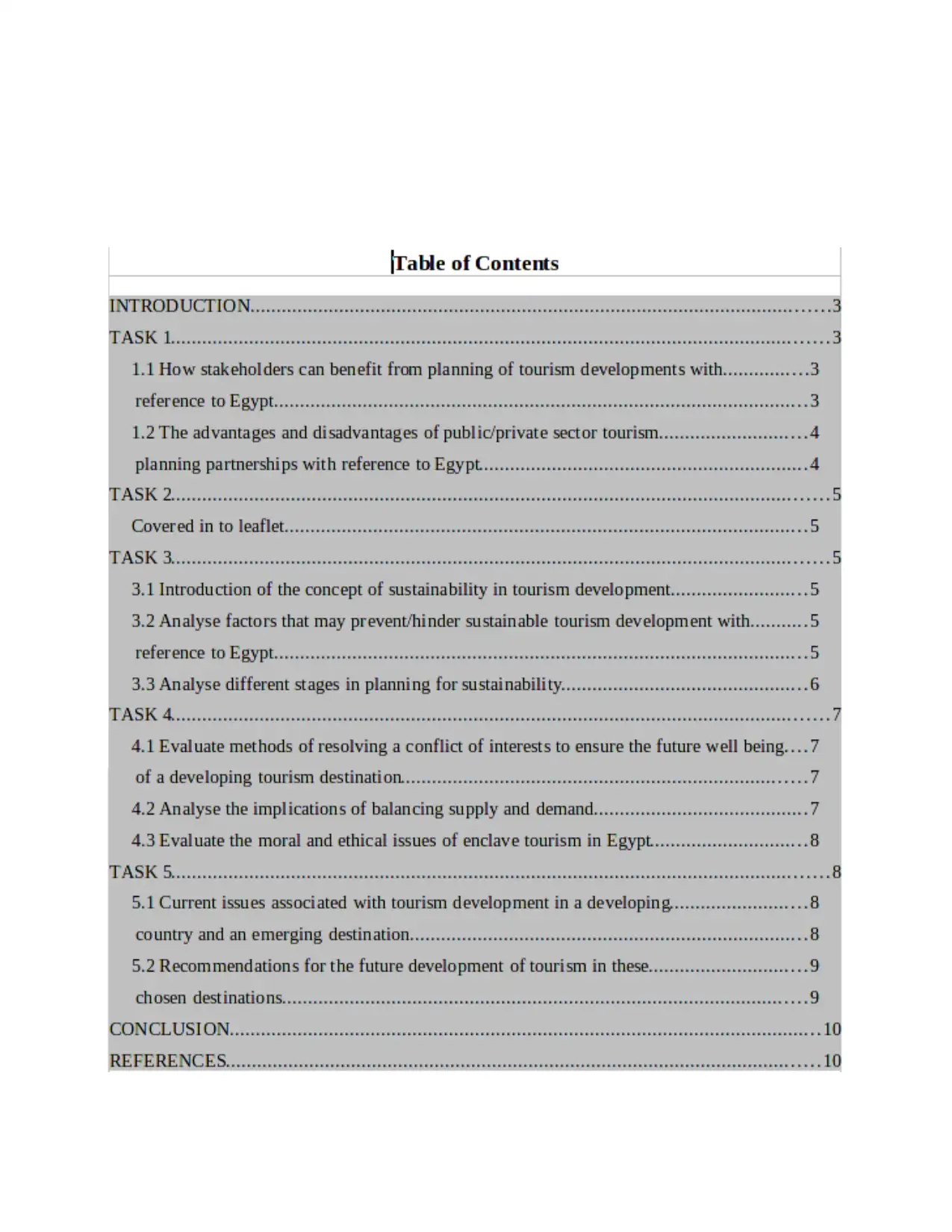
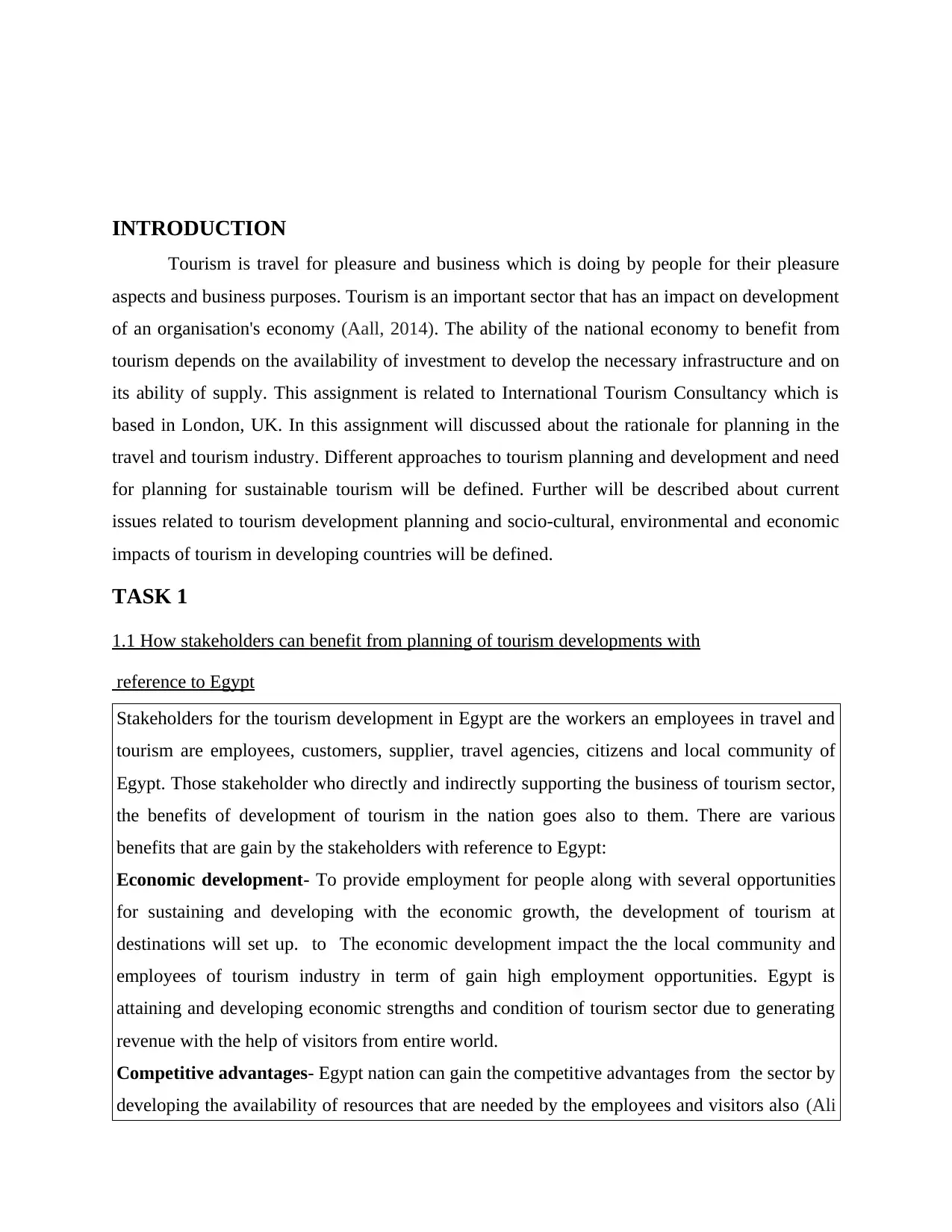
INTRODUCTION
Tourism is travel for pleasure and business which is doing by people for their pleasure
aspects and business purposes. Tourism is an important sector that has an impact on development
of an organisation's economy (Aall, 2014). The ability of the national economy to benefit from
tourism depends on the availability of investment to develop the necessary infrastructure and on
its ability of supply. This assignment is related to International Tourism Consultancy which is
based in London, UK. In this assignment will discussed about the rationale for planning in the
travel and tourism industry. Different approaches to tourism planning and development and need
for planning for sustainable tourism will be defined. Further will be described about current
issues related to tourism development planning and socio-cultural, environmental and economic
impacts of tourism in developing countries will be defined.
TASK 1
1.1 How stakeholders can benefit from planning of tourism developments with
reference to Egypt
Stakeholders for the tourism development in Egypt are the workers an employees in travel and
tourism are employees, customers, supplier, travel agencies, citizens and local community of
Egypt. Those stakeholder who directly and indirectly supporting the business of tourism sector,
the benefits of development of tourism in the nation goes also to them. There are various
benefits that are gain by the stakeholders with reference to Egypt:
Economic development- To provide employment for people along with several opportunities
for sustaining and developing with the economic growth, the development of tourism at
destinations will set up. to The economic development impact the the local community and
employees of tourism industry in term of gain high employment opportunities. Egypt is
attaining and developing economic strengths and condition of tourism sector due to generating
revenue with the help of visitors from entire world.
Competitive advantages- Egypt nation can gain the competitive advantages from the sector by
developing the availability of resources that are needed by the employees and visitors also (Ali
Tourism is travel for pleasure and business which is doing by people for their pleasure
aspects and business purposes. Tourism is an important sector that has an impact on development
of an organisation's economy (Aall, 2014). The ability of the national economy to benefit from
tourism depends on the availability of investment to develop the necessary infrastructure and on
its ability of supply. This assignment is related to International Tourism Consultancy which is
based in London, UK. In this assignment will discussed about the rationale for planning in the
travel and tourism industry. Different approaches to tourism planning and development and need
for planning for sustainable tourism will be defined. Further will be described about current
issues related to tourism development planning and socio-cultural, environmental and economic
impacts of tourism in developing countries will be defined.
TASK 1
1.1 How stakeholders can benefit from planning of tourism developments with
reference to Egypt
Stakeholders for the tourism development in Egypt are the workers an employees in travel and
tourism are employees, customers, supplier, travel agencies, citizens and local community of
Egypt. Those stakeholder who directly and indirectly supporting the business of tourism sector,
the benefits of development of tourism in the nation goes also to them. There are various
benefits that are gain by the stakeholders with reference to Egypt:
Economic development- To provide employment for people along with several opportunities
for sustaining and developing with the economic growth, the development of tourism at
destinations will set up. to The economic development impact the the local community and
employees of tourism industry in term of gain high employment opportunities. Egypt is
attaining and developing economic strengths and condition of tourism sector due to generating
revenue with the help of visitors from entire world.
Competitive advantages- Egypt nation can gain the competitive advantages from the sector by
developing the availability of resources that are needed by the employees and visitors also (Ali
⊘ This is a preview!⊘
Do you want full access?
Subscribe today to unlock all pages.

Trusted by 1+ million students worldwide
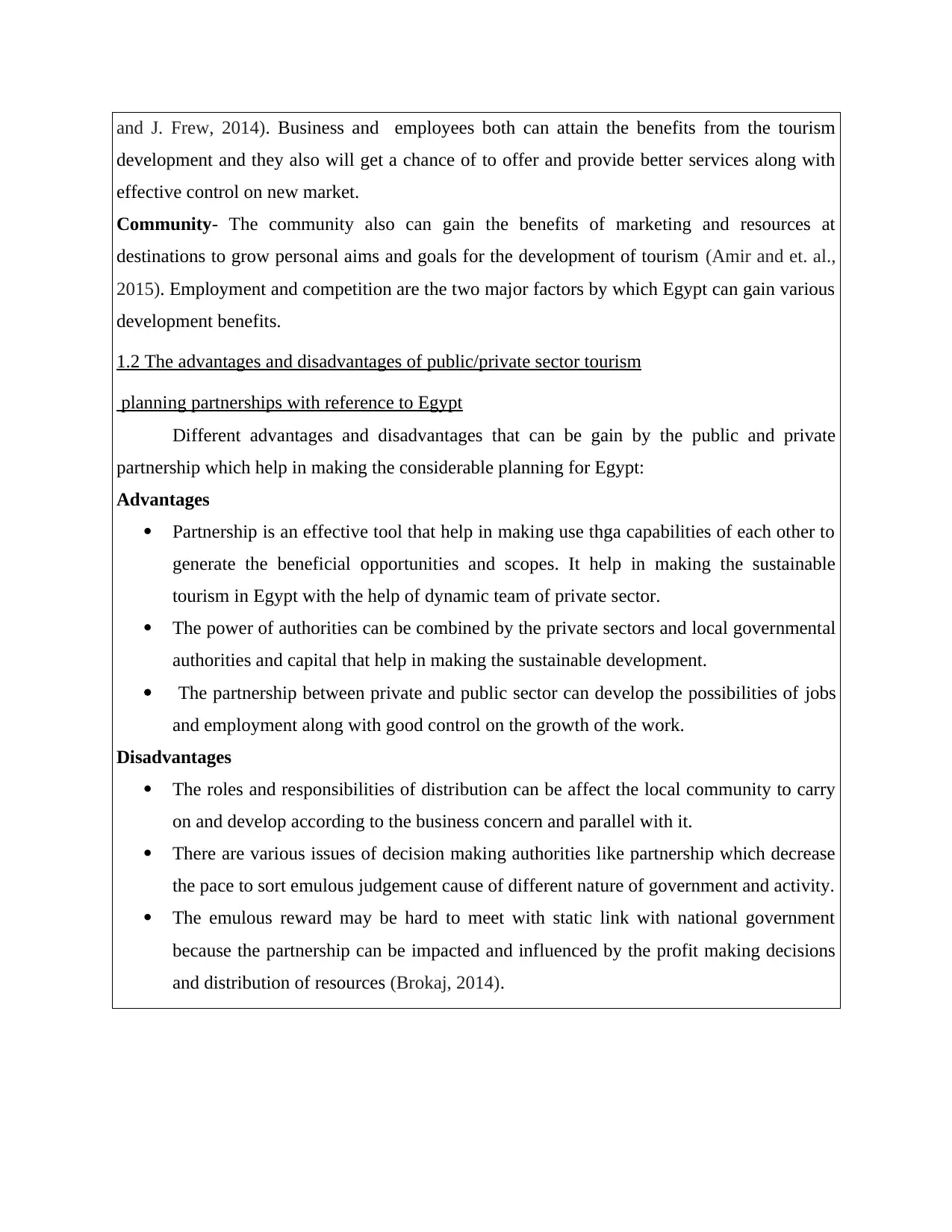
and J. Frew, 2014). Business and employees both can attain the benefits from the tourism
development and they also will get a chance of to offer and provide better services along with
effective control on new market.
Community- The community also can gain the benefits of marketing and resources at
destinations to grow personal aims and goals for the development of tourism (Amir and et. al.,
2015). Employment and competition are the two major factors by which Egypt can gain various
development benefits.
1.2 The advantages and disadvantages of public/private sector tourism
planning partnerships with reference to Egypt
Different advantages and disadvantages that can be gain by the public and private
partnership which help in making the considerable planning for Egypt:
Advantages
Partnership is an effective tool that help in making use thga capabilities of each other to
generate the beneficial opportunities and scopes. It help in making the sustainable
tourism in Egypt with the help of dynamic team of private sector.
The power of authorities can be combined by the private sectors and local governmental
authorities and capital that help in making the sustainable development.
The partnership between private and public sector can develop the possibilities of jobs
and employment along with good control on the growth of the work.
Disadvantages
The roles and responsibilities of distribution can be affect the local community to carry
on and develop according to the business concern and parallel with it.
There are various issues of decision making authorities like partnership which decrease
the pace to sort emulous judgement cause of different nature of government and activity.
The emulous reward may be hard to meet with static link with national government
because the partnership can be impacted and influenced by the profit making decisions
and distribution of resources (Brokaj, 2014).
development and they also will get a chance of to offer and provide better services along with
effective control on new market.
Community- The community also can gain the benefits of marketing and resources at
destinations to grow personal aims and goals for the development of tourism (Amir and et. al.,
2015). Employment and competition are the two major factors by which Egypt can gain various
development benefits.
1.2 The advantages and disadvantages of public/private sector tourism
planning partnerships with reference to Egypt
Different advantages and disadvantages that can be gain by the public and private
partnership which help in making the considerable planning for Egypt:
Advantages
Partnership is an effective tool that help in making use thga capabilities of each other to
generate the beneficial opportunities and scopes. It help in making the sustainable
tourism in Egypt with the help of dynamic team of private sector.
The power of authorities can be combined by the private sectors and local governmental
authorities and capital that help in making the sustainable development.
The partnership between private and public sector can develop the possibilities of jobs
and employment along with good control on the growth of the work.
Disadvantages
The roles and responsibilities of distribution can be affect the local community to carry
on and develop according to the business concern and parallel with it.
There are various issues of decision making authorities like partnership which decrease
the pace to sort emulous judgement cause of different nature of government and activity.
The emulous reward may be hard to meet with static link with national government
because the partnership can be impacted and influenced by the profit making decisions
and distribution of resources (Brokaj, 2014).
Paraphrase This Document
Need a fresh take? Get an instant paraphrase of this document with our AI Paraphraser
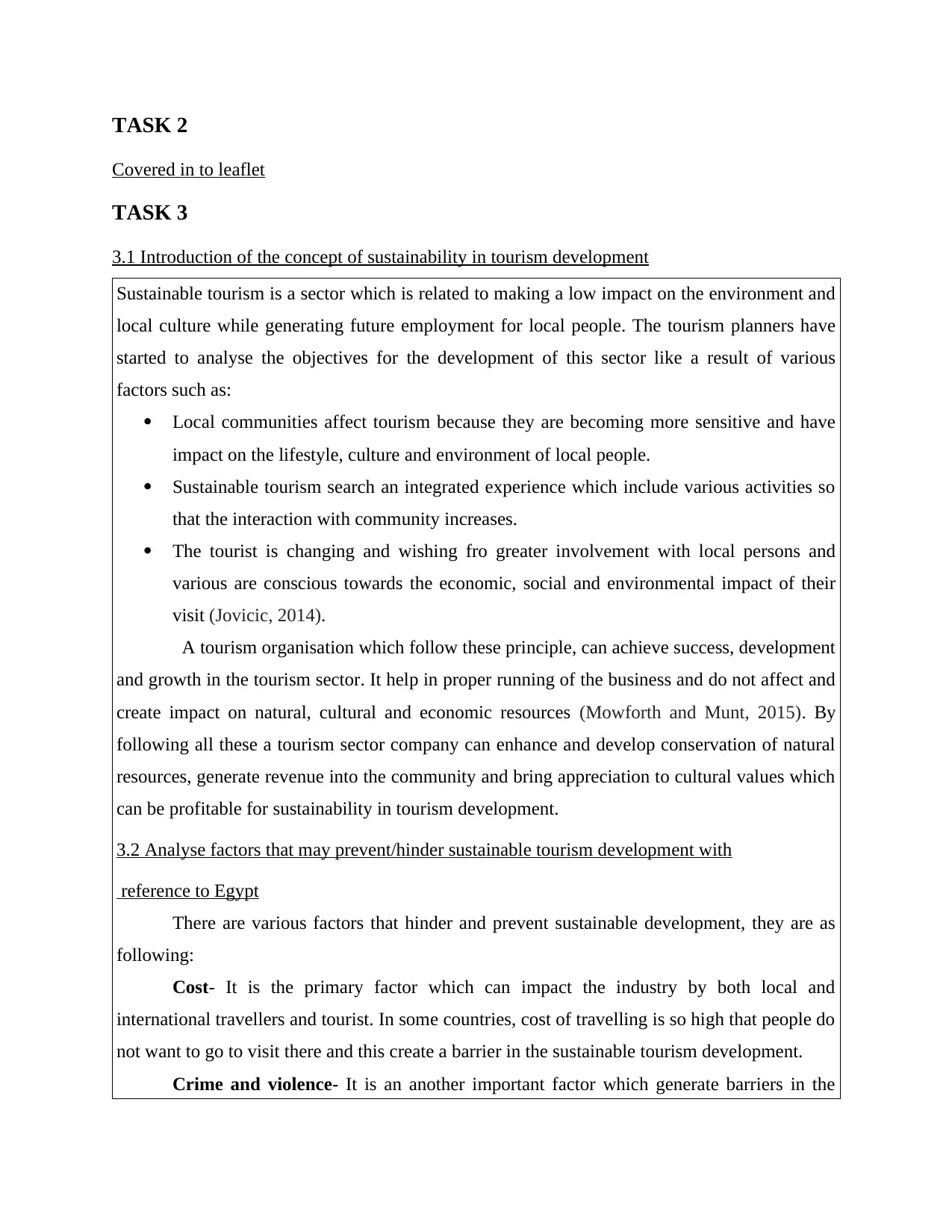
TASK 2
Covered in to leaflet
TASK 3
3.1 Introduction of the concept of sustainability in tourism development
Sustainable tourism is a sector which is related to making a low impact on the environment and
local culture while generating future employment for local people. The tourism planners have
started to analyse the objectives for the development of this sector like a result of various
factors such as:
Local communities affect tourism because they are becoming more sensitive and have
impact on the lifestyle, culture and environment of local people.
Sustainable tourism search an integrated experience which include various activities so
that the interaction with community increases.
The tourist is changing and wishing fro greater involvement with local persons and
various are conscious towards the economic, social and environmental impact of their
visit (Jovicic, 2014).
A tourism organisation which follow these principle, can achieve success, development
and growth in the tourism sector. It help in proper running of the business and do not affect and
create impact on natural, cultural and economic resources (Mowforth and Munt, 2015). By
following all these a tourism sector company can enhance and develop conservation of natural
resources, generate revenue into the community and bring appreciation to cultural values which
can be profitable for sustainability in tourism development.
3.2 Analyse factors that may prevent/hinder sustainable tourism development with
reference to Egypt
There are various factors that hinder and prevent sustainable development, they are as
following:
Cost- It is the primary factor which can impact the industry by both local and
international travellers and tourist. In some countries, cost of travelling is so high that people do
not want to go to visit there and this create a barrier in the sustainable tourism development.
Crime and violence- It is an another important factor which generate barriers in the
Covered in to leaflet
TASK 3
3.1 Introduction of the concept of sustainability in tourism development
Sustainable tourism is a sector which is related to making a low impact on the environment and
local culture while generating future employment for local people. The tourism planners have
started to analyse the objectives for the development of this sector like a result of various
factors such as:
Local communities affect tourism because they are becoming more sensitive and have
impact on the lifestyle, culture and environment of local people.
Sustainable tourism search an integrated experience which include various activities so
that the interaction with community increases.
The tourist is changing and wishing fro greater involvement with local persons and
various are conscious towards the economic, social and environmental impact of their
visit (Jovicic, 2014).
A tourism organisation which follow these principle, can achieve success, development
and growth in the tourism sector. It help in proper running of the business and do not affect and
create impact on natural, cultural and economic resources (Mowforth and Munt, 2015). By
following all these a tourism sector company can enhance and develop conservation of natural
resources, generate revenue into the community and bring appreciation to cultural values which
can be profitable for sustainability in tourism development.
3.2 Analyse factors that may prevent/hinder sustainable tourism development with
reference to Egypt
There are various factors that hinder and prevent sustainable development, they are as
following:
Cost- It is the primary factor which can impact the industry by both local and
international travellers and tourist. In some countries, cost of travelling is so high that people do
not want to go to visit there and this create a barrier in the sustainable tourism development.
Crime and violence- It is an another important factor which generate barriers in the
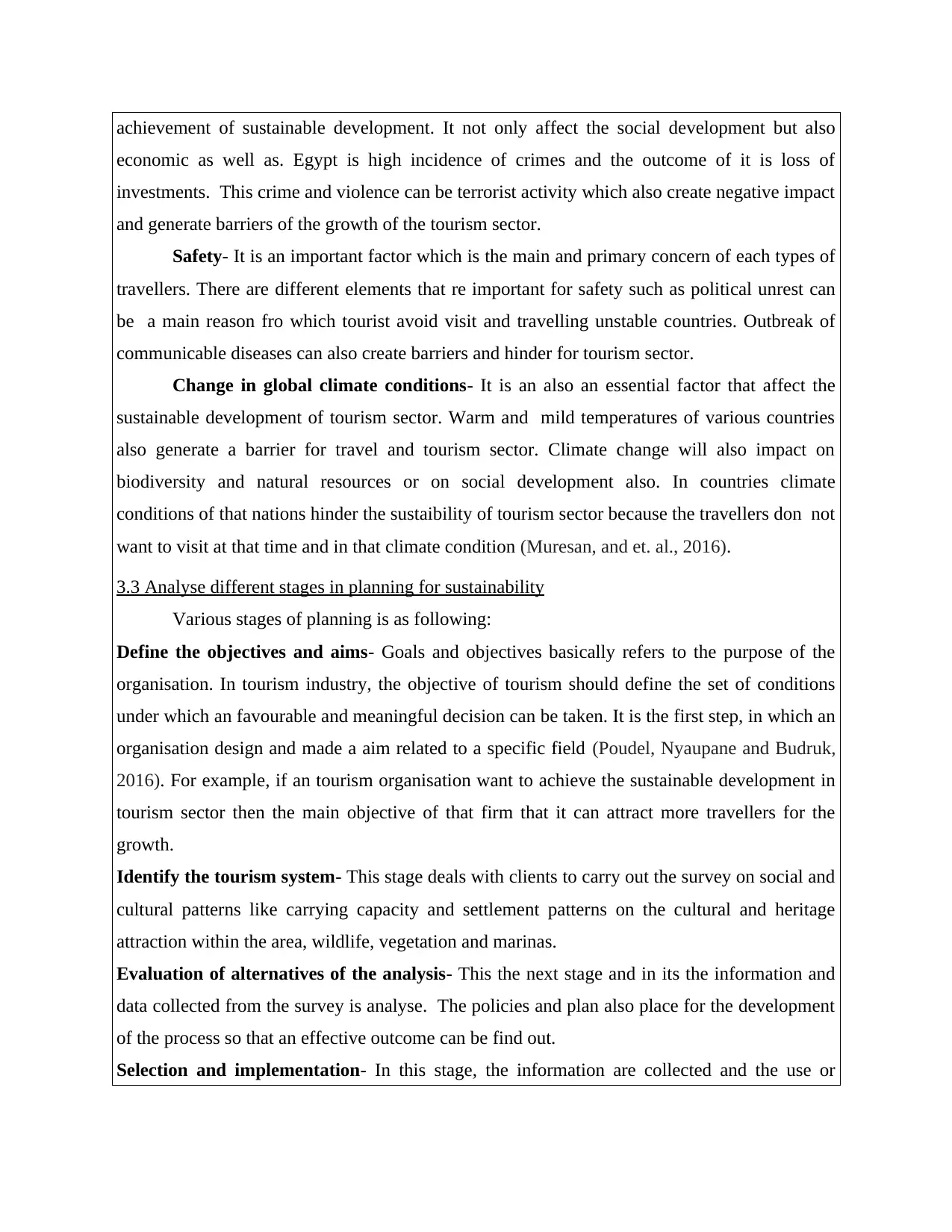
achievement of sustainable development. It not only affect the social development but also
economic as well as. Egypt is high incidence of crimes and the outcome of it is loss of
investments. This crime and violence can be terrorist activity which also create negative impact
and generate barriers of the growth of the tourism sector.
Safety- It is an important factor which is the main and primary concern of each types of
travellers. There are different elements that re important for safety such as political unrest can
be a main reason fro which tourist avoid visit and travelling unstable countries. Outbreak of
communicable diseases can also create barriers and hinder for tourism sector.
Change in global climate conditions- It is an also an essential factor that affect the
sustainable development of tourism sector. Warm and mild temperatures of various countries
also generate a barrier for travel and tourism sector. Climate change will also impact on
biodiversity and natural resources or on social development also. In countries climate
conditions of that nations hinder the sustaibility of tourism sector because the travellers don not
want to visit at that time and in that climate condition (Muresan, and et. al., 2016).
3.3 Analyse different stages in planning for sustainability
Various stages of planning is as following:
Define the objectives and aims- Goals and objectives basically refers to the purpose of the
organisation. In tourism industry, the objective of tourism should define the set of conditions
under which an favourable and meaningful decision can be taken. It is the first step, in which an
organisation design and made a aim related to a specific field (Poudel, Nyaupane and Budruk,
2016). For example, if an tourism organisation want to achieve the sustainable development in
tourism sector then the main objective of that firm that it can attract more travellers for the
growth.
Identify the tourism system- This stage deals with clients to carry out the survey on social and
cultural patterns like carrying capacity and settlement patterns on the cultural and heritage
attraction within the area, wildlife, vegetation and marinas.
Evaluation of alternatives of the analysis- This the next stage and in its the information and
data collected from the survey is analyse. The policies and plan also place for the development
of the process so that an effective outcome can be find out.
Selection and implementation- In this stage, the information are collected and the use or
economic as well as. Egypt is high incidence of crimes and the outcome of it is loss of
investments. This crime and violence can be terrorist activity which also create negative impact
and generate barriers of the growth of the tourism sector.
Safety- It is an important factor which is the main and primary concern of each types of
travellers. There are different elements that re important for safety such as political unrest can
be a main reason fro which tourist avoid visit and travelling unstable countries. Outbreak of
communicable diseases can also create barriers and hinder for tourism sector.
Change in global climate conditions- It is an also an essential factor that affect the
sustainable development of tourism sector. Warm and mild temperatures of various countries
also generate a barrier for travel and tourism sector. Climate change will also impact on
biodiversity and natural resources or on social development also. In countries climate
conditions of that nations hinder the sustaibility of tourism sector because the travellers don not
want to visit at that time and in that climate condition (Muresan, and et. al., 2016).
3.3 Analyse different stages in planning for sustainability
Various stages of planning is as following:
Define the objectives and aims- Goals and objectives basically refers to the purpose of the
organisation. In tourism industry, the objective of tourism should define the set of conditions
under which an favourable and meaningful decision can be taken. It is the first step, in which an
organisation design and made a aim related to a specific field (Poudel, Nyaupane and Budruk,
2016). For example, if an tourism organisation want to achieve the sustainable development in
tourism sector then the main objective of that firm that it can attract more travellers for the
growth.
Identify the tourism system- This stage deals with clients to carry out the survey on social and
cultural patterns like carrying capacity and settlement patterns on the cultural and heritage
attraction within the area, wildlife, vegetation and marinas.
Evaluation of alternatives of the analysis- This the next stage and in its the information and
data collected from the survey is analyse. The policies and plan also place for the development
of the process so that an effective outcome can be find out.
Selection and implementation- In this stage, the information are collected and the use or
⊘ This is a preview!⊘
Do you want full access?
Subscribe today to unlock all pages.

Trusted by 1+ million students worldwide
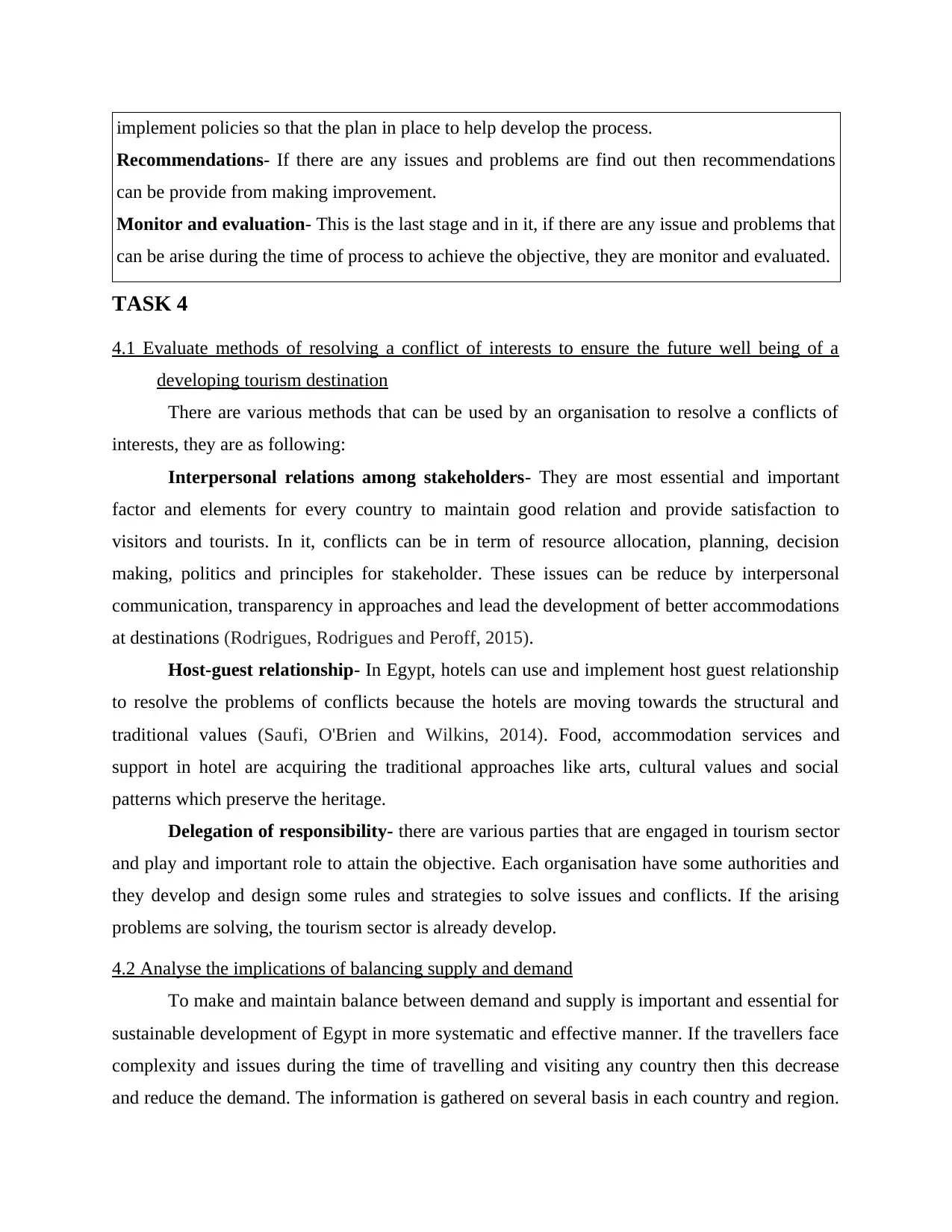
implement policies so that the plan in place to help develop the process.
Recommendations- If there are any issues and problems are find out then recommendations
can be provide from making improvement.
Monitor and evaluation- This is the last stage and in it, if there are any issue and problems that
can be arise during the time of process to achieve the objective, they are monitor and evaluated.
TASK 4
4.1 Evaluate methods of resolving a conflict of interests to ensure the future well being of a
developing tourism destination
There are various methods that can be used by an organisation to resolve a conflicts of
interests, they are as following:
Interpersonal relations among stakeholders- They are most essential and important
factor and elements for every country to maintain good relation and provide satisfaction to
visitors and tourists. In it, conflicts can be in term of resource allocation, planning, decision
making, politics and principles for stakeholder. These issues can be reduce by interpersonal
communication, transparency in approaches and lead the development of better accommodations
at destinations (Rodrigues, Rodrigues and Peroff, 2015).
Host-guest relationship- In Egypt, hotels can use and implement host guest relationship
to resolve the problems of conflicts because the hotels are moving towards the structural and
traditional values (Saufi, O'Brien and Wilkins, 2014). Food, accommodation services and
support in hotel are acquiring the traditional approaches like arts, cultural values and social
patterns which preserve the heritage.
Delegation of responsibility- there are various parties that are engaged in tourism sector
and play and important role to attain the objective. Each organisation have some authorities and
they develop and design some rules and strategies to solve issues and conflicts. If the arising
problems are solving, the tourism sector is already develop.
4.2 Analyse the implications of balancing supply and demand
To make and maintain balance between demand and supply is important and essential for
sustainable development of Egypt in more systematic and effective manner. If the travellers face
complexity and issues during the time of travelling and visiting any country then this decrease
and reduce the demand. The information is gathered on several basis in each country and region.
Recommendations- If there are any issues and problems are find out then recommendations
can be provide from making improvement.
Monitor and evaluation- This is the last stage and in it, if there are any issue and problems that
can be arise during the time of process to achieve the objective, they are monitor and evaluated.
TASK 4
4.1 Evaluate methods of resolving a conflict of interests to ensure the future well being of a
developing tourism destination
There are various methods that can be used by an organisation to resolve a conflicts of
interests, they are as following:
Interpersonal relations among stakeholders- They are most essential and important
factor and elements for every country to maintain good relation and provide satisfaction to
visitors and tourists. In it, conflicts can be in term of resource allocation, planning, decision
making, politics and principles for stakeholder. These issues can be reduce by interpersonal
communication, transparency in approaches and lead the development of better accommodations
at destinations (Rodrigues, Rodrigues and Peroff, 2015).
Host-guest relationship- In Egypt, hotels can use and implement host guest relationship
to resolve the problems of conflicts because the hotels are moving towards the structural and
traditional values (Saufi, O'Brien and Wilkins, 2014). Food, accommodation services and
support in hotel are acquiring the traditional approaches like arts, cultural values and social
patterns which preserve the heritage.
Delegation of responsibility- there are various parties that are engaged in tourism sector
and play and important role to attain the objective. Each organisation have some authorities and
they develop and design some rules and strategies to solve issues and conflicts. If the arising
problems are solving, the tourism sector is already develop.
4.2 Analyse the implications of balancing supply and demand
To make and maintain balance between demand and supply is important and essential for
sustainable development of Egypt in more systematic and effective manner. If the travellers face
complexity and issues during the time of travelling and visiting any country then this decrease
and reduce the demand. The information is gathered on several basis in each country and region.
Paraphrase This Document
Need a fresh take? Get an instant paraphrase of this document with our AI Paraphraser
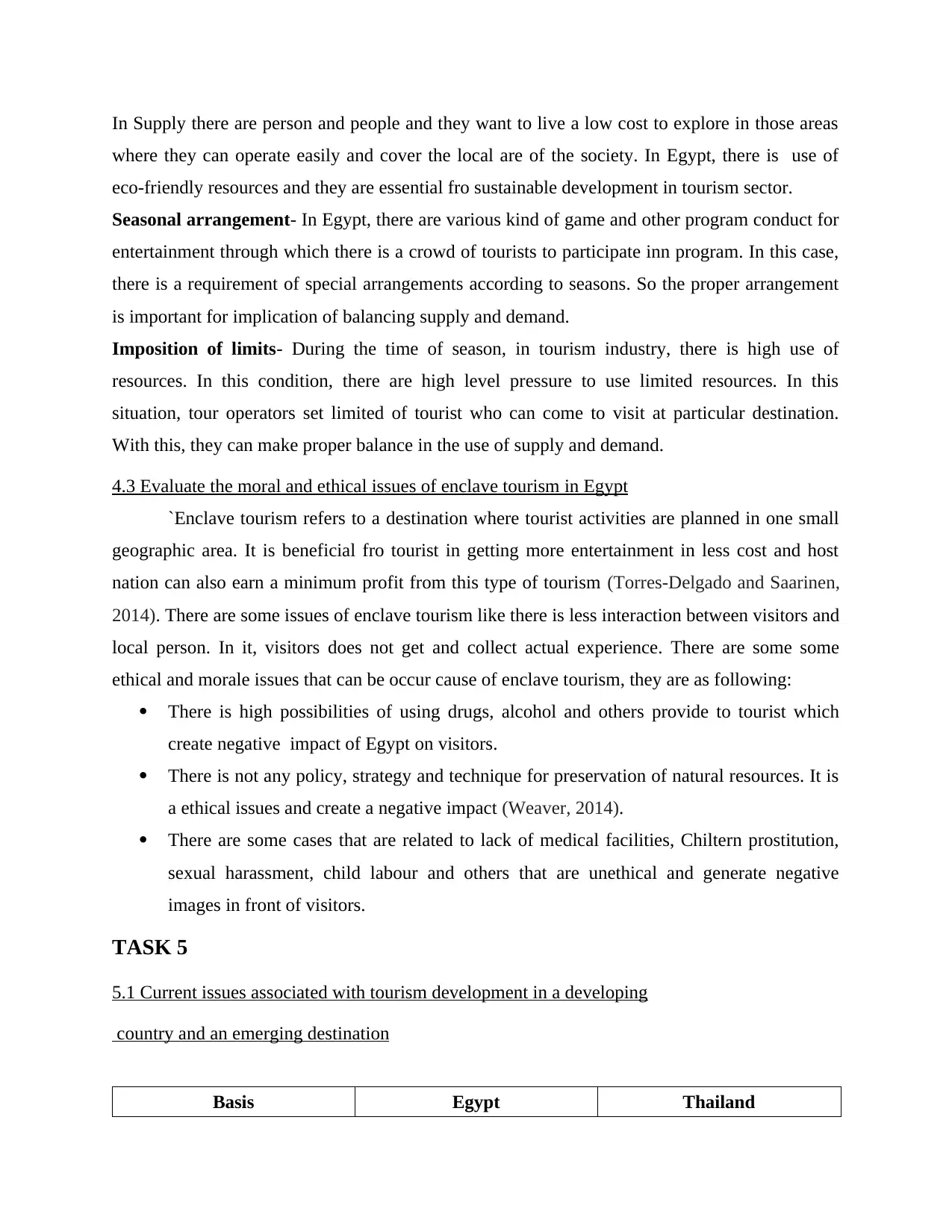
In Supply there are person and people and they want to live a low cost to explore in those areas
where they can operate easily and cover the local are of the society. In Egypt, there is use of
eco-friendly resources and they are essential fro sustainable development in tourism sector.
Seasonal arrangement- In Egypt, there are various kind of game and other program conduct for
entertainment through which there is a crowd of tourists to participate inn program. In this case,
there is a requirement of special arrangements according to seasons. So the proper arrangement
is important for implication of balancing supply and demand.
Imposition of limits- During the time of season, in tourism industry, there is high use of
resources. In this condition, there are high level pressure to use limited resources. In this
situation, tour operators set limited of tourist who can come to visit at particular destination.
With this, they can make proper balance in the use of supply and demand.
4.3 Evaluate the moral and ethical issues of enclave tourism in Egypt
`Enclave tourism refers to a destination where tourist activities are planned in one small
geographic area. It is beneficial fro tourist in getting more entertainment in less cost and host
nation can also earn a minimum profit from this type of tourism (Torres-Delgado and Saarinen,
2014). There are some issues of enclave tourism like there is less interaction between visitors and
local person. In it, visitors does not get and collect actual experience. There are some some
ethical and morale issues that can be occur cause of enclave tourism, they are as following:
There is high possibilities of using drugs, alcohol and others provide to tourist which
create negative impact of Egypt on visitors.
There is not any policy, strategy and technique for preservation of natural resources. It is
a ethical issues and create a negative impact (Weaver, 2014).
There are some cases that are related to lack of medical facilities, Chiltern prostitution,
sexual harassment, child labour and others that are unethical and generate negative
images in front of visitors.
TASK 5
5.1 Current issues associated with tourism development in a developing
country and an emerging destination
Basis Egypt Thailand
where they can operate easily and cover the local are of the society. In Egypt, there is use of
eco-friendly resources and they are essential fro sustainable development in tourism sector.
Seasonal arrangement- In Egypt, there are various kind of game and other program conduct for
entertainment through which there is a crowd of tourists to participate inn program. In this case,
there is a requirement of special arrangements according to seasons. So the proper arrangement
is important for implication of balancing supply and demand.
Imposition of limits- During the time of season, in tourism industry, there is high use of
resources. In this condition, there are high level pressure to use limited resources. In this
situation, tour operators set limited of tourist who can come to visit at particular destination.
With this, they can make proper balance in the use of supply and demand.
4.3 Evaluate the moral and ethical issues of enclave tourism in Egypt
`Enclave tourism refers to a destination where tourist activities are planned in one small
geographic area. It is beneficial fro tourist in getting more entertainment in less cost and host
nation can also earn a minimum profit from this type of tourism (Torres-Delgado and Saarinen,
2014). There are some issues of enclave tourism like there is less interaction between visitors and
local person. In it, visitors does not get and collect actual experience. There are some some
ethical and morale issues that can be occur cause of enclave tourism, they are as following:
There is high possibilities of using drugs, alcohol and others provide to tourist which
create negative impact of Egypt on visitors.
There is not any policy, strategy and technique for preservation of natural resources. It is
a ethical issues and create a negative impact (Weaver, 2014).
There are some cases that are related to lack of medical facilities, Chiltern prostitution,
sexual harassment, child labour and others that are unethical and generate negative
images in front of visitors.
TASK 5
5.1 Current issues associated with tourism development in a developing
country and an emerging destination
Basis Egypt Thailand
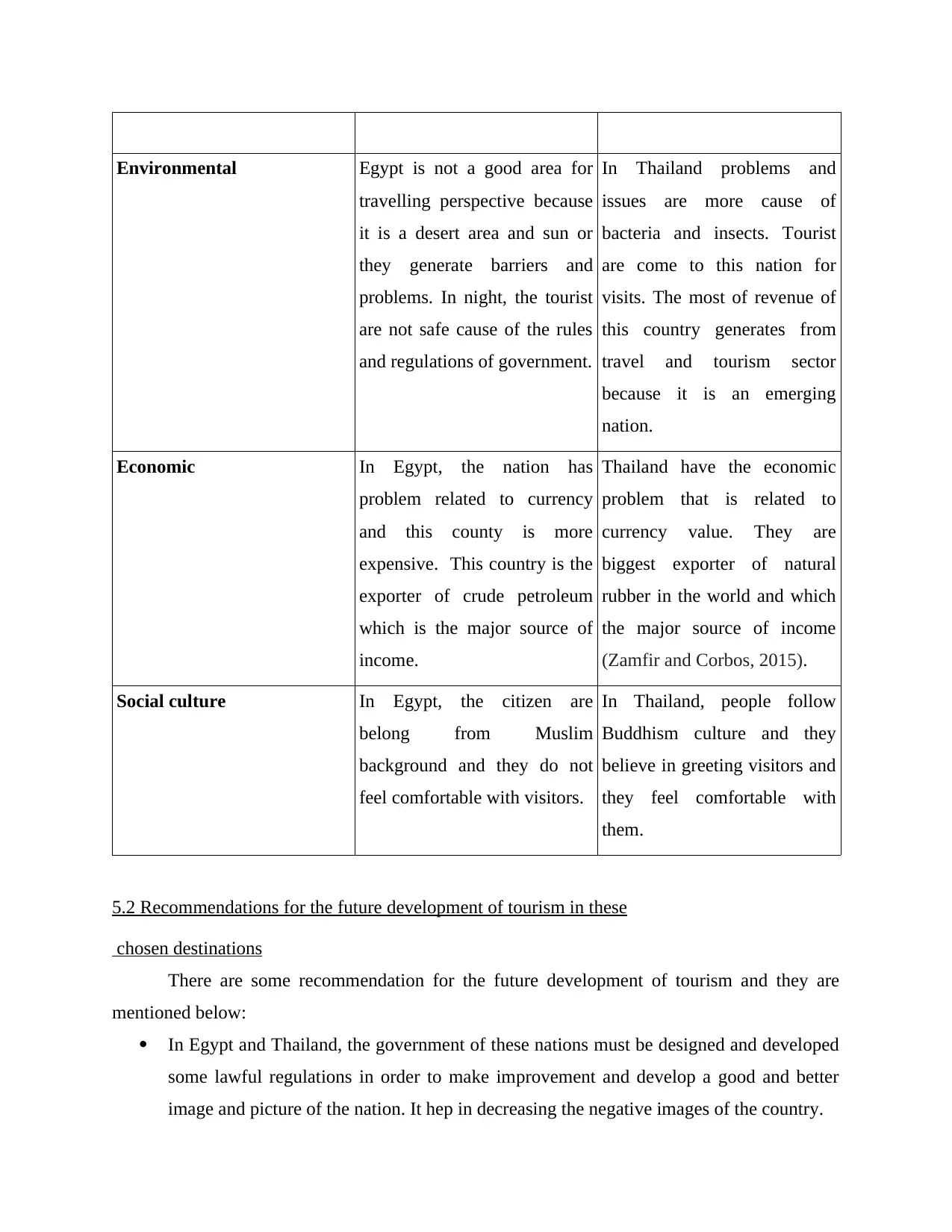
Environmental Egypt is not a good area for
travelling perspective because
it is a desert area and sun or
they generate barriers and
problems. In night, the tourist
are not safe cause of the rules
and regulations of government.
In Thailand problems and
issues are more cause of
bacteria and insects. Tourist
are come to this nation for
visits. The most of revenue of
this country generates from
travel and tourism sector
because it is an emerging
nation.
Economic In Egypt, the nation has
problem related to currency
and this county is more
expensive. This country is the
exporter of crude petroleum
which is the major source of
income.
Thailand have the economic
problem that is related to
currency value. They are
biggest exporter of natural
rubber in the world and which
the major source of income
(Zamfir and Corbos, 2015).
Social culture In Egypt, the citizen are
belong from Muslim
background and they do not
feel comfortable with visitors.
In Thailand, people follow
Buddhism culture and they
believe in greeting visitors and
they feel comfortable with
them.
5.2 Recommendations for the future development of tourism in these
chosen destinations
There are some recommendation for the future development of tourism and they are
mentioned below:
In Egypt and Thailand, the government of these nations must be designed and developed
some lawful regulations in order to make improvement and develop a good and better
image and picture of the nation. It hep in decreasing the negative images of the country.
travelling perspective because
it is a desert area and sun or
they generate barriers and
problems. In night, the tourist
are not safe cause of the rules
and regulations of government.
In Thailand problems and
issues are more cause of
bacteria and insects. Tourist
are come to this nation for
visits. The most of revenue of
this country generates from
travel and tourism sector
because it is an emerging
nation.
Economic In Egypt, the nation has
problem related to currency
and this county is more
expensive. This country is the
exporter of crude petroleum
which is the major source of
income.
Thailand have the economic
problem that is related to
currency value. They are
biggest exporter of natural
rubber in the world and which
the major source of income
(Zamfir and Corbos, 2015).
Social culture In Egypt, the citizen are
belong from Muslim
background and they do not
feel comfortable with visitors.
In Thailand, people follow
Buddhism culture and they
believe in greeting visitors and
they feel comfortable with
them.
5.2 Recommendations for the future development of tourism in these
chosen destinations
There are some recommendation for the future development of tourism and they are
mentioned below:
In Egypt and Thailand, the government of these nations must be designed and developed
some lawful regulations in order to make improvement and develop a good and better
image and picture of the nation. It hep in decreasing the negative images of the country.
⊘ This is a preview!⊘
Do you want full access?
Subscribe today to unlock all pages.

Trusted by 1+ million students worldwide
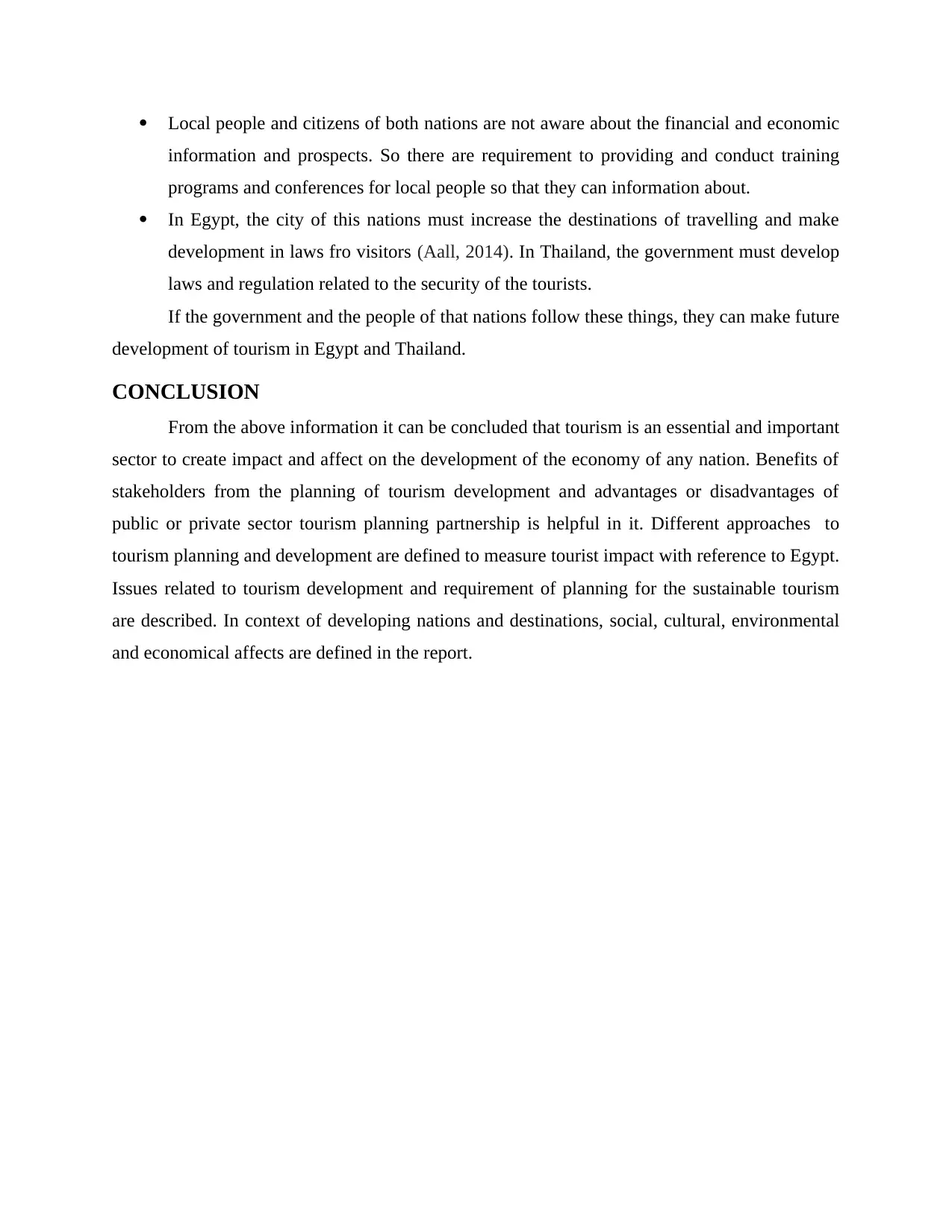
Local people and citizens of both nations are not aware about the financial and economic
information and prospects. So there are requirement to providing and conduct training
programs and conferences for local people so that they can information about.
In Egypt, the city of this nations must increase the destinations of travelling and make
development in laws fro visitors (Aall, 2014). In Thailand, the government must develop
laws and regulation related to the security of the tourists.
If the government and the people of that nations follow these things, they can make future
development of tourism in Egypt and Thailand.
CONCLUSION
From the above information it can be concluded that tourism is an essential and important
sector to create impact and affect on the development of the economy of any nation. Benefits of
stakeholders from the planning of tourism development and advantages or disadvantages of
public or private sector tourism planning partnership is helpful in it. Different approaches to
tourism planning and development are defined to measure tourist impact with reference to Egypt.
Issues related to tourism development and requirement of planning for the sustainable tourism
are described. In context of developing nations and destinations, social, cultural, environmental
and economical affects are defined in the report.
information and prospects. So there are requirement to providing and conduct training
programs and conferences for local people so that they can information about.
In Egypt, the city of this nations must increase the destinations of travelling and make
development in laws fro visitors (Aall, 2014). In Thailand, the government must develop
laws and regulation related to the security of the tourists.
If the government and the people of that nations follow these things, they can make future
development of tourism in Egypt and Thailand.
CONCLUSION
From the above information it can be concluded that tourism is an essential and important
sector to create impact and affect on the development of the economy of any nation. Benefits of
stakeholders from the planning of tourism development and advantages or disadvantages of
public or private sector tourism planning partnership is helpful in it. Different approaches to
tourism planning and development are defined to measure tourist impact with reference to Egypt.
Issues related to tourism development and requirement of planning for the sustainable tourism
are described. In context of developing nations and destinations, social, cultural, environmental
and economical affects are defined in the report.
Paraphrase This Document
Need a fresh take? Get an instant paraphrase of this document with our AI Paraphraser
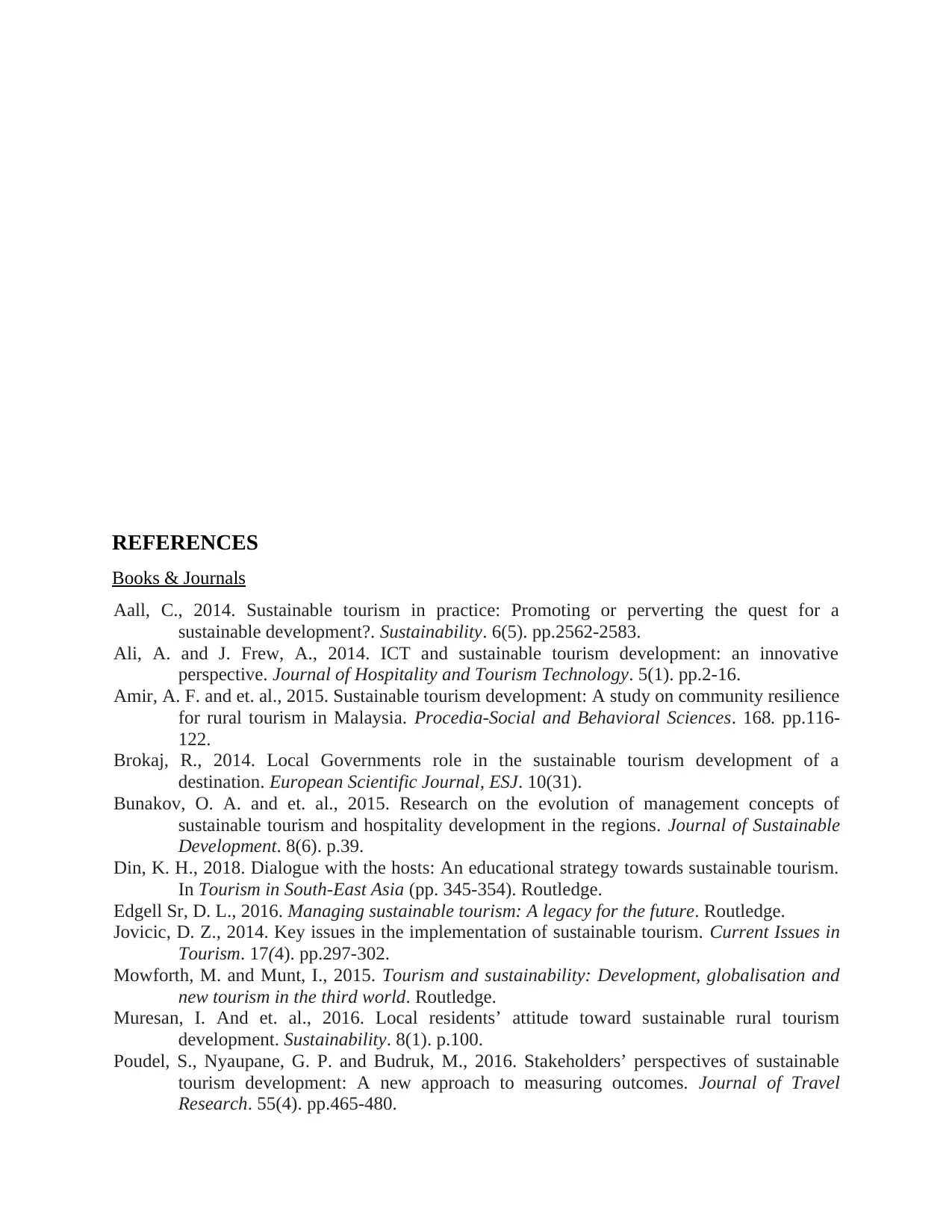
REFERENCES
Books & Journals
Aall, C., 2014. Sustainable tourism in practice: Promoting or perverting the quest for a
sustainable development?. Sustainability. 6(5). pp.2562-2583.
Ali, A. and J. Frew, A., 2014. ICT and sustainable tourism development: an innovative
perspective. Journal of Hospitality and Tourism Technology. 5(1). pp.2-16.
Amir, A. F. and et. al., 2015. Sustainable tourism development: A study on community resilience
for rural tourism in Malaysia. Procedia-Social and Behavioral Sciences. 168. pp.116-
122.
Brokaj, R., 2014. Local Governments role in the sustainable tourism development of a
destination. European Scientific Journal, ESJ. 10(31).
Bunakov, O. A. and et. al., 2015. Research on the evolution of management concepts of
sustainable tourism and hospitality development in the regions. Journal of Sustainable
Development. 8(6). p.39.
Din, K. H., 2018. Dialogue with the hosts: An educational strategy towards sustainable tourism.
In Tourism in South-East Asia (pp. 345-354). Routledge.
Edgell Sr, D. L., 2016. Managing sustainable tourism: A legacy for the future. Routledge.
Jovicic, D. Z., 2014. Key issues in the implementation of sustainable tourism. Current Issues in
Tourism. 17(4). pp.297-302.
Mowforth, M. and Munt, I., 2015. Tourism and sustainability: Development, globalisation and
new tourism in the third world. Routledge.
Muresan, I. And et. al., 2016. Local residents’ attitude toward sustainable rural tourism
development. Sustainability. 8(1). p.100.
Poudel, S., Nyaupane, G. P. and Budruk, M., 2016. Stakeholders’ perspectives of sustainable
tourism development: A new approach to measuring outcomes. Journal of Travel
Research. 55(4). pp.465-480.
Books & Journals
Aall, C., 2014. Sustainable tourism in practice: Promoting or perverting the quest for a
sustainable development?. Sustainability. 6(5). pp.2562-2583.
Ali, A. and J. Frew, A., 2014. ICT and sustainable tourism development: an innovative
perspective. Journal of Hospitality and Tourism Technology. 5(1). pp.2-16.
Amir, A. F. and et. al., 2015. Sustainable tourism development: A study on community resilience
for rural tourism in Malaysia. Procedia-Social and Behavioral Sciences. 168. pp.116-
122.
Brokaj, R., 2014. Local Governments role in the sustainable tourism development of a
destination. European Scientific Journal, ESJ. 10(31).
Bunakov, O. A. and et. al., 2015. Research on the evolution of management concepts of
sustainable tourism and hospitality development in the regions. Journal of Sustainable
Development. 8(6). p.39.
Din, K. H., 2018. Dialogue with the hosts: An educational strategy towards sustainable tourism.
In Tourism in South-East Asia (pp. 345-354). Routledge.
Edgell Sr, D. L., 2016. Managing sustainable tourism: A legacy for the future. Routledge.
Jovicic, D. Z., 2014. Key issues in the implementation of sustainable tourism. Current Issues in
Tourism. 17(4). pp.297-302.
Mowforth, M. and Munt, I., 2015. Tourism and sustainability: Development, globalisation and
new tourism in the third world. Routledge.
Muresan, I. And et. al., 2016. Local residents’ attitude toward sustainable rural tourism
development. Sustainability. 8(1). p.100.
Poudel, S., Nyaupane, G. P. and Budruk, M., 2016. Stakeholders’ perspectives of sustainable
tourism development: A new approach to measuring outcomes. Journal of Travel
Research. 55(4). pp.465-480.
1 out of 11
Related Documents
Your All-in-One AI-Powered Toolkit for Academic Success.
+13062052269
info@desklib.com
Available 24*7 on WhatsApp / Email
![[object Object]](/_next/static/media/star-bottom.7253800d.svg)
Unlock your academic potential
Copyright © 2020–2025 A2Z Services. All Rights Reserved. Developed and managed by ZUCOL.





